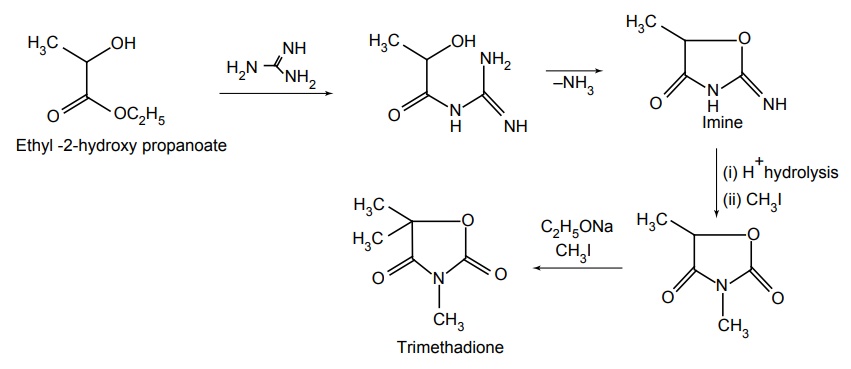Oxazolidinediones
| Home | | Medicinal Chemistry |Chapter: Medicinal Chemistry : Anticonvulsants
Anticonvulsants - Oxazolidinediones - Synthesis and Drug Profile - a. Trimethadione (Tridione) b. Paramethadione (Paradione) - Structure, Properties, uses, Synthesis, Assay, Storage, Dosage forms, Dose | Synthesis and Drug Profile
SYNTHESIS AND DRUG PROFILE
Oxazolidinediones
General method for synthesis of oxazolidine dione derivatives

a. Trimethadione (Tridione)
Synthesis
Route-I. From Ethyl-2-hydroxy propanoate

RouteII. From: Propane-2-one

Metabolism: It is metabolized by N-demethylation to putative active metabolite dimethadone and it is further excreted unchanged.
Properties and uses: It is a colourless or almost colourless crystals, soluble in water and alcohol. It is first drug introduced specifically for treating absence seizures. It is important as a prototype structure for antiabsence seizure compounds. It is used as an antipetitmal agent. It causes nephrosis, aplastic anaemia and bone marrow depression.
Assay: Assayed by adopting gas chromatography technique.
Storage: It should be stored in well-closed airtight containers.
Dose: The usual dose is 900 mg to 2.4 g per day; usually 300 to 600 mg 2 to 4 times daily.
b. Paramethadione (Paradione)

Synthesis

Properties and uses: It is an oily liquid, slightly soluble in water and freely soluble in ethanol. It is used as an anticonvulsant.
Dose: The usual dose is 300 mg to 2.4 g daily.
